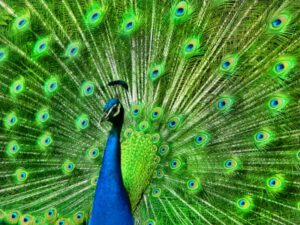
An animal’s ability to survive often depends on how well it can avoid predators. Many species of fish, birds, and mammals have evolved ingenious methods of staying hidden from predators by blending into the background in one form or another.
But what about animals that do the opposite? How and why would such attention-grabbing features as a lion’s mane, a male deer’s antlers, or a peacock’s tail evolve?
As it turns out, these traits can be explained by something called sexual selection. Sexual selection is an aspect of evolutionary theory developed by Charles Darwin in the 19th century after he began to notice many traits that were exaggerated, especially among the male members of the species. Darwin reasoned that within a species, there must be a “struggle between the individuals of one sex, generally the males, for the possession of the other sex.” So in the same way that women may prefer men with broad shoulders, female peacocks prefer their male counterparts to have ornate feathers — the larger the better.
Evolutionary biologists have understood the concept of sexual selection for years, but there has been much debate over how this process occurs at the genetic level. For example, male and female lions have basically the same set of genes. So how are these genes modified such that male lions develop a mane while females do not? The answer, as it turns out, is surprisingly simple.
In this week’s issue of Cell, molecular biologists tackled the question of how sexual selection works by examining the genetics of fruit flies. Male fruit flies have evolved a unique coloring pattern on their abdomens that apparently attracts females in the same way that a peacock’s feathers do. Females lack the markings, yet they have basically the same genome males do. So how is it that the same basic genome (aside from sex chromosomes) can lead males and females to develop different physical traits?
According to University of Wisonsin-Madison biologist Sean Carroll, “The flies did not need new genes … they just changed how males and females use a common set of genes.”
Carroll and his team discovered that while both male and female fruit flies have the genes necessary to create the abdominal coloring pattern, it is only the males who have that gene switched on. In female fruit flies, this gene lies dormant.
“With this particular trait, it evolved by exploiting (genetic) information that was already there to make male bodies different from female bodies,’ explains Carroll.
So how does the genetics of a coloring pattern on fruit fly abdomens apply to sexual selection in other species? According to Carroll and his colleagues, the same genetic mechanisms that are at play in the fruit fly also operate in a multitude of other animals — including lions, deer, peacocks, and even humans.
This study, in showing the genetic means for how sexual selection may operate, illustrates the ingenuity of evolution — how a seemingly simple genetic switch can create such beautiful and elaborate features in the male members of thousands of the world’s species.